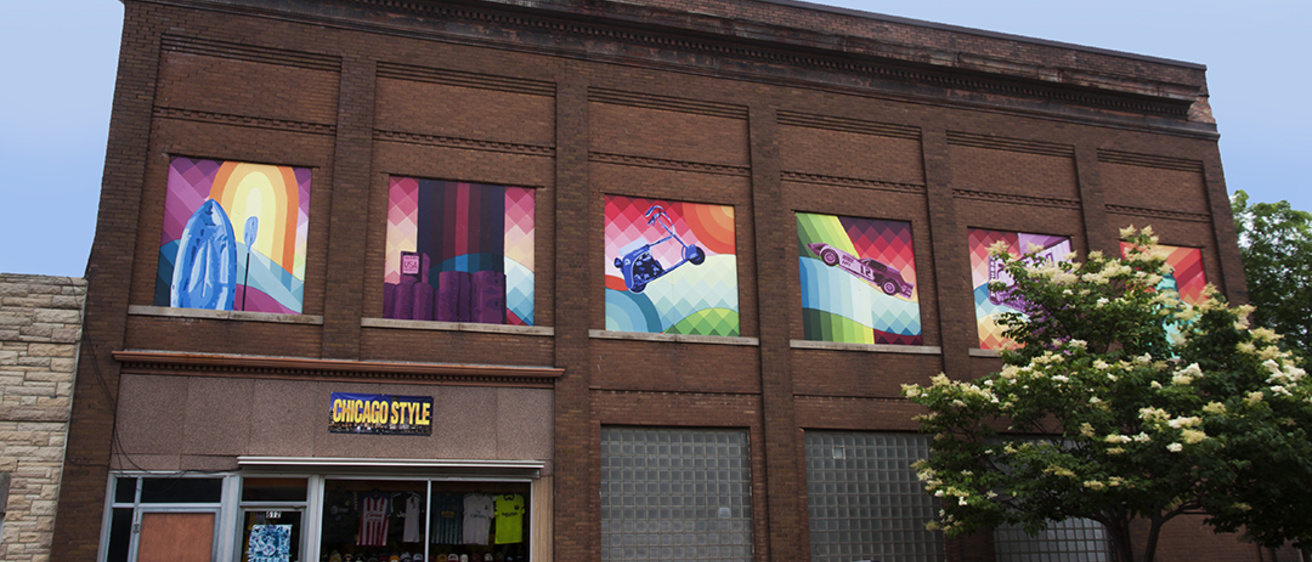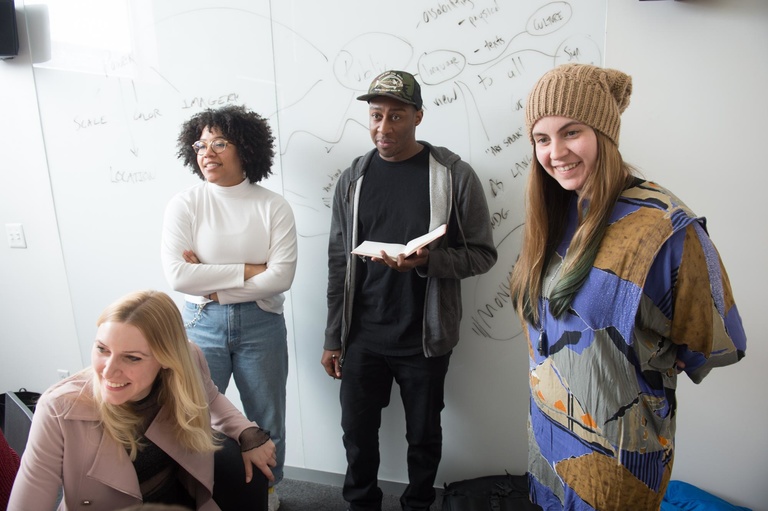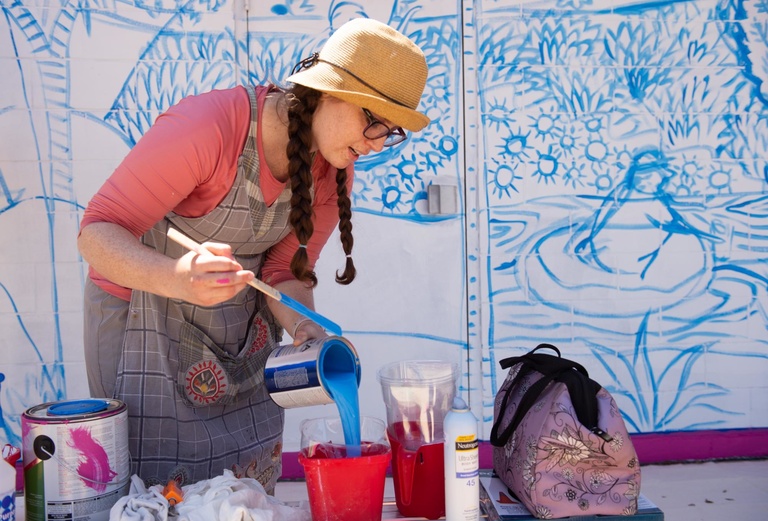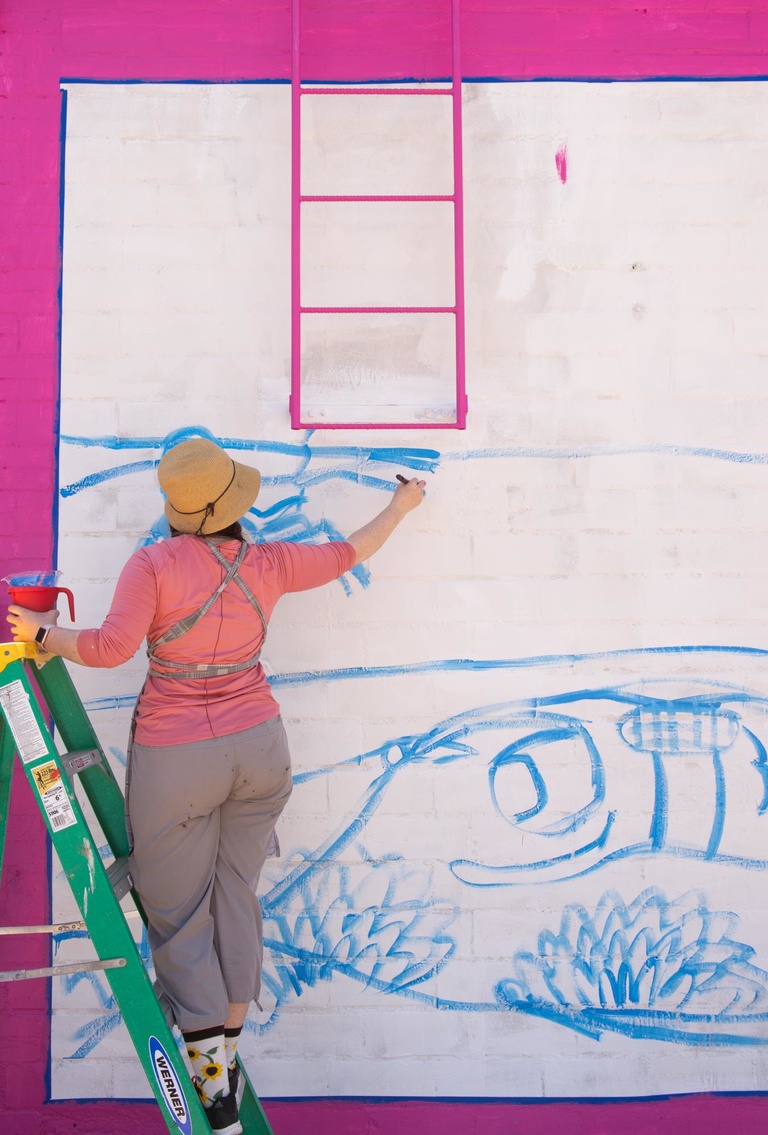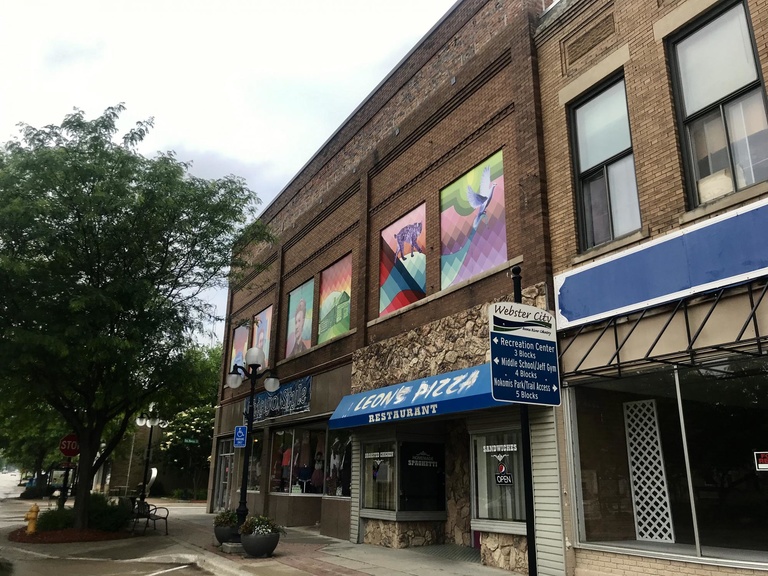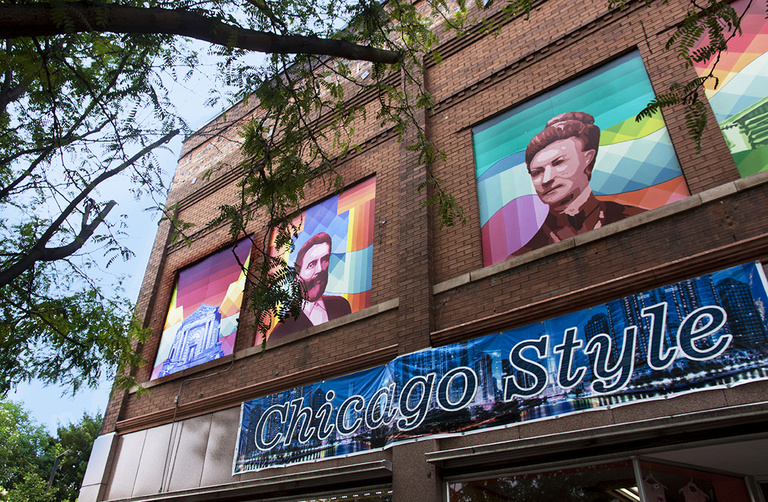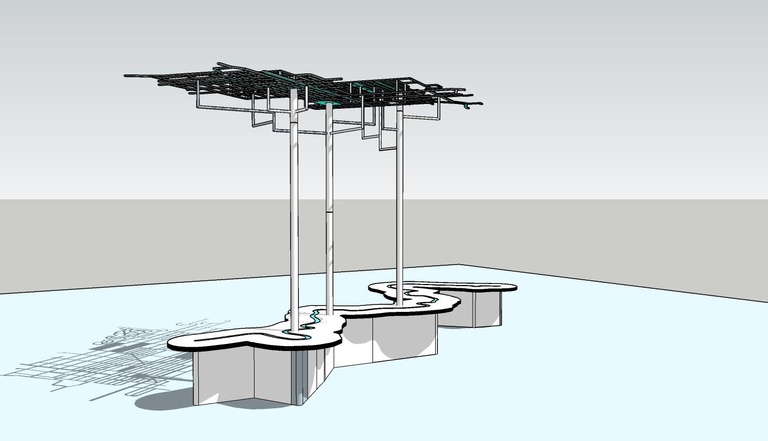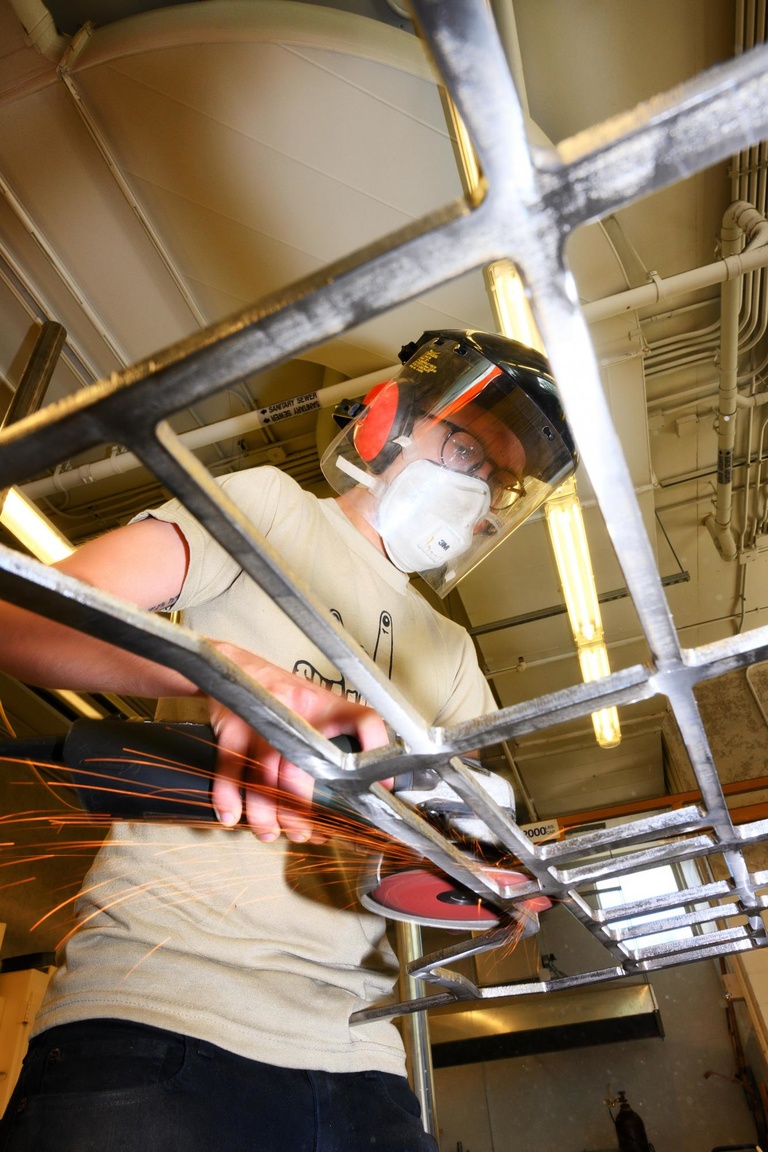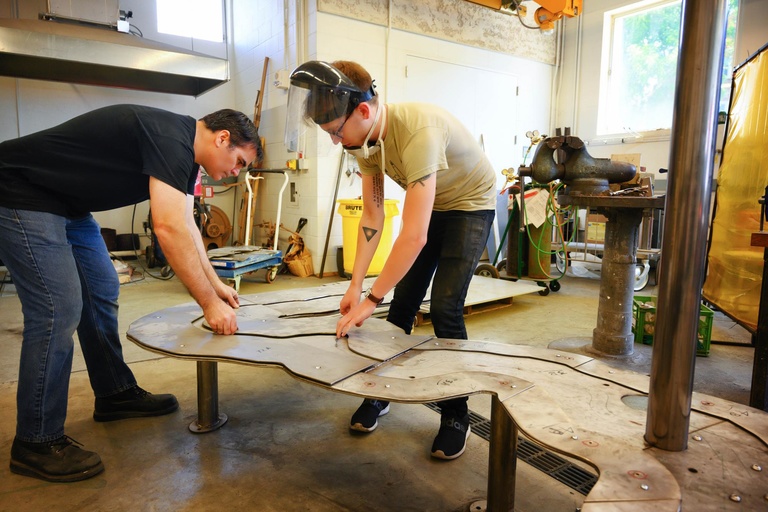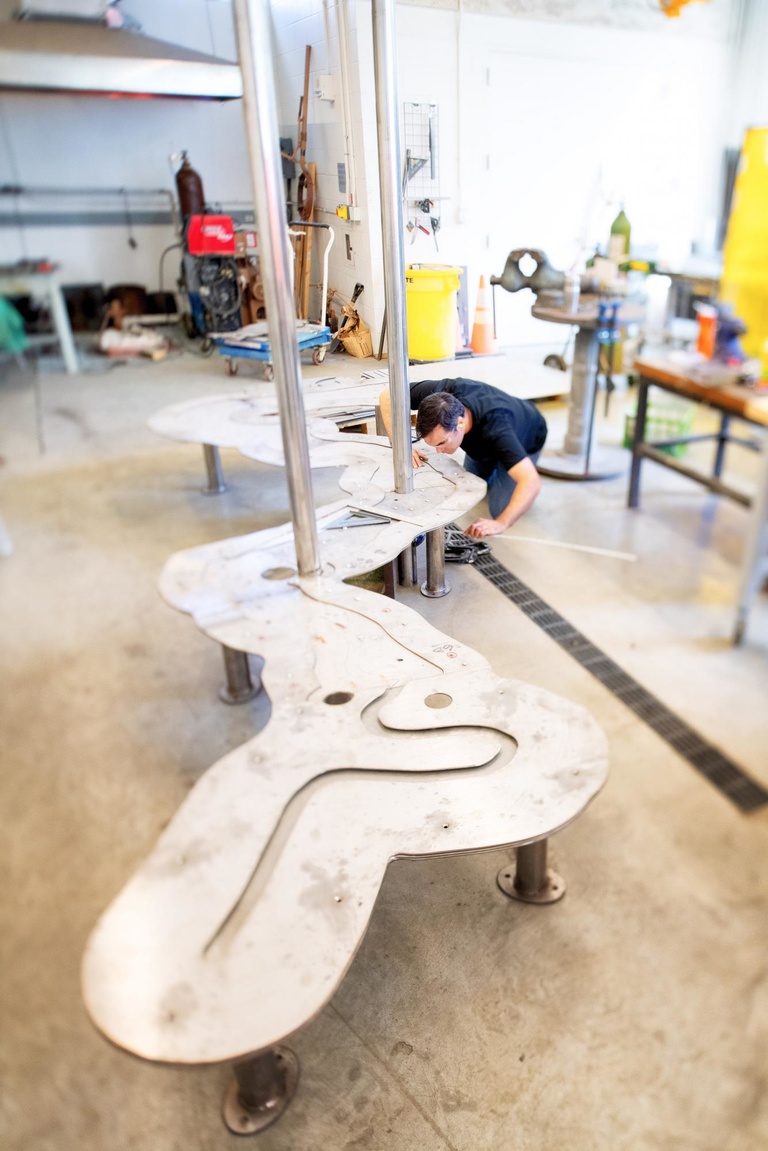The Office of Outreach and Engagement at the University of Iowa partners with Iowa communities on dozens of projects each year. One of the most popular requests: public art. In fact, the office often receives more requests for public art than resources can provide.
Iowa communities where UI students are creating public art this summer
- Clarence
- Iowa City
- Keokuk
- Lowden
- Maquoketa
- Mechanicsville
- Stanwood
- Tipton
- Webster City
- West Branch
Thanks in part to a new residency program to train students in the intricacies of creating public art, boarded-up windows, concrete walls, and fertilizer bins will become canvases for large-scale public art projects in 10 Iowa communities this summer. One city also will welcome a large-scale, solar-powered sculpture to its downtown plaza.
“Public art has been positioned as a driver of economic reinvestment,” says Vero Rose Smith, associate curator at the UI Stanley Museum of Art and one of two faculty members working on the inaugural Grant Wood Public Art Residency. “It’s hard to document; it’s obliquely provable. But it does at the very least demonstrate a renewed sense of value and investment on an emotional level in the fabric of a place.”
Maura Pilcher, director of the Iowa’s Grant Wood Art Colony, says communities realize the importance of public art as place-making tools.
“Our students enter communities with fresh eyes, recognizing assets while appreciating local history and culture,” Pilcher says. “Each process and product is as unique as the people and places that shape it.”
Grant Wood Public Art Residency
The UI has deep ties to public art. In 1934, artist Grant Wood was appointed head of the New Deal’s Public Works of Art Project (PWAP) for the state—a precursor to a Works Progress Administration (WPA) program. It was about that time that the UI offered Wood a teaching position and a studio in which to produce the murals he was hired to create.
“The residency serves Iowans and carries on Grant Wood’s legacy in a very literal way,” Pilcher says. “It’s responding to community needs with UI resources and, obviously, it’s a great opportunity for these students. We had heard from faculty and students that one of the best gigs you can get right out of school is public art commissions. But our students didn’t always have the training in how to get those commissions—details like how to propose a project, how to scope and budget a project, how to get permits. And then on top of it, how to engage a community in the process.”
Pilcher says a partnership with Cedar County provided the perfect opportunity around which to build a residency, as six communities in the county were interested in murals.
Nine students—most from Iowa’s School of Art and Art History but also one from the College of Engineering—took part in the inaugural weeklong Grant Wood Public Art Residency over spring break in March. The residency was led by Smith and Thomas Agran, director of public art for the Iowa City Downtown District.
Students during the week discussed the politics of art in public spaces; learned about diverse artistic materials and methods; explored issues surrounding insurance, contracts, and budgets; and toured six Cedar County communities and spoke with residents. The week culminated with each student presenting concepts to their colleagues and members of the public.
“I was thrilled with the work students were able to produce in a single week, and I think it speaks really well of their ability to embed in a community and create something that is meaningful and beautiful,” Smith says. “If they could do that in a week, what can they do in two weeks, a month, or more?”
All students in the residency were offered an opportunity to create a mural in an Iowa community this summer. While some already had other projects scheduled for summer, four students are in the process of creating murals in at least two communities each.
- Alexis Beucler: Iowa City, Mechanicsville, Stanwood
- Drew Etienne: Maquoketa, Tipton
- Katlynne Hummell: Clarence, Lowden
- Ali Hval: Keokuk, West Branch, Webster City
Students say the March residency was intense but informative. Katlynne Hummell graduated in May 2019 with a BFA in painting and drawing. The Eldon, Iowa, native says that without it, she never would have been ready to take on large projects such as a mural that incorporates four fertilizer bins in Lowden.
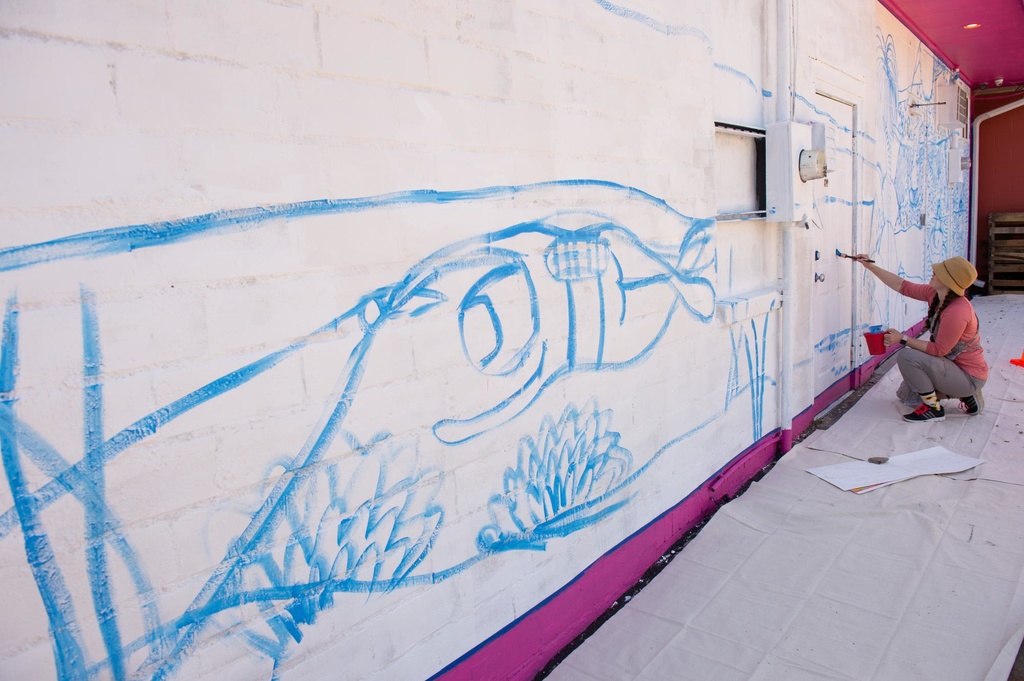
“I had never thought about contracts and budgets. I never thought about using scaffolding versus a lift, or needing to use a specific mural paint instead of general exterior paint. I didn’t know about tuckpointing,” Hummell says. “This residency really opened my eyes and prepared me for the real world. It will be a big adventure. It will be a lot of work, but a lot of fun.”
Drew Etienne, who is working toward his MFA in painting, completed a few public art projects before the residency. But the Indiana native says those projects included a lot of trial and error.
“Things worked out pretty well, but I knew there were some gaps of knowledge to fill in,” Etienne says. “I learned more in that one week than I had in my entire life about the theory behind public art, the purpose of it, how to even define it. I feel like I was able to skip ahead through all the trial and error I would have had to do myself.”
Part of the residency was spent discussing various materials and methods for creating murals. For his mural in Tipton, Etienne is using aluminum composite panels that will be affixed to a building. He says this method offers benefits to the community.
“If there’s anything that needs to be done with the building, or they want to move the art somewhere else, or building ownership changes hands, the mural is able to stay intact,” Etienne says. “They’ll be able to take it apart and put it back together somewhere else. And that’s something I absolutely would not have considered before the residency.”
The residency also provided students a chance to network with professionals in the field, which led to a commission for Alexis Beucler, a Florida native working toward an MFA in painting and drawing with a secondary focus in printmaking. When a couple of Iowa City businesses were seeking an artist for a mural on the back of their building, Agran realized that Beucler’s artistic style matched the businesses’ vision and recommended her.
Along with the Cedar County towns, Pilcher says Maquoketa also contacted her office about a mural, and the residency allowed her to pair that community with an artist as well.
Murals, sculpture for IISC partners
As the 2018–19 partner of the Iowa Initiative for Sustainable Communities (IISC)—a program housed in Iowa’s Office of Outreach and Engagement—Webster City proposed two public art projects: a mural and a solar art sculpture.
Does your town want to work with the Office of Outreach and Engagement?
The Office of Outreach and Engagement can help connect your community to University of Iowa resources.
Whether you’re looking to host an event in your community, collaborate with faculty and students on a community project, or find a faculty partner for community-based research, the office can help find the best on-campus matches to address your community’s needs and priorities.
Learn more.
Ali Hval, a Birmingham, Alabama, native who graduated from the UI in May 2019 with an MFA in painting and drawing, has designed murals in six Iowa communities during her time in the state so far. For Webster City, she painted 12 8-by-8-foot panels that replaced wood that covered the building’s windows.
“Webster City has history that can be played up in the mural I designed that may otherwise be unknown or overlooked by people in the town or those passing through,” Hval says. “I enjoy being able to see what differentiates one place from the next and how that can be capitalized on in public art.”
Meanwhile, Dan Miller, assistant professor in the UI’s School of Art and Art History, is fabricating a solar-powered sculpture for downtown Webster City.
Functioning as a bench, the sculpture mimics the shape of the Boone River, which meanders through Webster City. Columns rising from the bench will support precision-cut metal screens, referencing a canopy of trees but also the Webster City street map. During the day, sunlight will cast a shadow of the street map on the ground. At night, thanks to power provided by solar panels, the river will project blue light and green hues onto the metal canopy above.

“The piece itself is going to be made out of stainless steel, and it’s a substantial sculpture,” Miller says. “But it’s very much a sculpture about light. We’re using active and passive light with the sun shining through and the solar panels providing power.”
The professor is being assisted by May 2019 UI graduates Christian Woodruff and Duncan Moore. The sculpture will be installed in late summer.
“Webster City counts itself very fortunate to introduce new public art to the community through our partnership with the university,” says Lindsay Henderson, Webster City community vitality director. “The colorful mural created by Ali Hval tells the story of Webster City’s past, present, and future on a large building on a prominent corner of our downtown. With Professor Miller’s solar sculpture placed at the opposite end of the district, next to our City Hall, the two works will create beautiful bookends that grab the attention of visitors and residents alike.”
As the IISC winds down its work with Webster City, it’s ramping up efforts with its 2019–20 partner, Keokuk. And one of the first projects on deck: creating a mural, which Hval also will install this summer.
